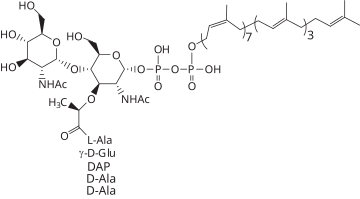
| |
| Names | |
|---|---|
| Systematic IUPAC name
(2R,5R,8S,13R,16S,19R)-19-{[(2R,3R,4R,5S,6R)-3-Acetamido-5-{[(2S,3R,4R,5S,6R)-3-acetamido-4,5-dihydroxy-6-(hydroxymethyl)oxan-2-yl]oxy}-2-[(1,3-dihydroxy-1,3-dioxo-3-{[(2Z,6Z,10Z,14Z,18Z,22Z,26Z,30Z,34E,38E,42E)-3,7,11,15,19,23,27,31,35,39,43-undecamethyltetratetraconta-2,6,10,14,18,22,26,30,34,38,42-undecaen-1-yl]oxy}-1λ5,3λ5-diphosphoxan-1-yl)oxy]-6-(hydroxymethyl)oxan-4-yl]oxy}-8-(4-aminobutyl)-13-carboxy-2,5,16-trimethyl-4,7,10,15,18-pentaoxo-3,6,9,14,17-pentaazaicosan-1-oic acid | |
| Identifiers | |
3D model (JSmol)
|
|
| 9039417 | |
| ChEBI | |
| ChemSpider | |
| KEGG | |
PubChem CID
|
|
CompTox Dashboard (EPA)
|
|
| |
| |
| Properties | |
| C94H156N8O26P2 | |
| Molar mass | 1876.23 g·mol−1 |
Except where otherwise noted, data are given for materials in their standard state (at 25 °C [77 °F], 100 kPa).
| |
Lipid II is a precursor molecule in the synthesis of the cell wall of bacteria. It is a peptidoglycan, which is amphipathic and named for its bactoprenol hydrocarbon chain, which acts as a lipid anchor, embedding itself in the bacterial cell membrane. Lipid II must translocate across the cell membrane to deliver and incorporate its disaccharide-pentapeptide "building block" into the peptidoglycan mesh. Lipid II is the target of several antibiotics.
A number of analogous compounds are produced via a similar pathway in some bacteria, giving rise to cell wall modifications. See EC 2.4.1.227 for more information.[2]
- ^ Senf, L.; Schmidt, U.; Anger, G. (1 October 1977). [339578-22-2 "[Clearance computation from the blood level following a single injection of 125-I-hippuran]"]. Zeitschrift Fur Die Gesamte Innere Medizin Und Ihre Grenzgebiete. pp. 508–513.
{{cite web}}: Check|url=value (help) - ^ "MetaCyc EC 2.4.1.227". biocyc.org.